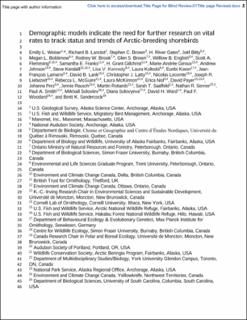Annual adult survival drives trends in Arctic-breeding shorebirds but knowledge gaps in other vital rates remain
| dc.contributor.author | Weiser, Emily L. | |
| dc.contributor.author | Lanctot, Richard B. | |
| dc.contributor.author | Brown, Stephen C. | |
| dc.contributor.author | Gates, H. River | |
| dc.contributor.author | Bêty, Joël | |
| dc.contributor.author | Boldenow, Megan L. | |
| dc.contributor.author | Brook, Rodney W. | |
| dc.contributor.author | Brown, Glen S. | |
| dc.contributor.author | English, Willow B. | |
| dc.contributor.author | Flemming, Scott A. | |
| dc.contributor.author | Franks, Samantha E. | |
| dc.contributor.author | Gilchrist, H. Grant | |
| dc.contributor.author | Giroux, Marie-Andrée | |
| dc.contributor.author | Johnson, Andrew | |
| dc.contributor.author | Koloski, Laura | |
| dc.contributor.author | Kwon, Eunbi | |
| dc.contributor.author | Lamarre, Jean-François | |
| dc.contributor.author | Lank, David B. | |
| dc.contributor.author | Latty, Christopher J. | |
| dc.contributor.author | Lecomte, Nicolas | |
| dc.contributor.author | Liebezeit, Joseph R. | |
| dc.contributor.author | McGuire, Rebecca L. | |
| dc.contributor.author | McKinnon, Laura | |
| dc.contributor.author | Nol, Erica | |
| dc.contributor.author | Payer, David | |
| dc.contributor.author | Perz, Johanna | |
| dc.contributor.author | Rausch, Jennie | |
| dc.contributor.author | Robards, Martin | |
| dc.contributor.author | Saalfeld, Sarah T. | |
| dc.contributor.author | Senner, Nathan R. | |
| dc.contributor.author | Smith, Paul A. | |
| dc.contributor.author | Soloviev, Mikhail | |
| dc.contributor.author | Solovyeva, Diana | |
| dc.contributor.author | Ward, David H. | |
| dc.contributor.author | Woodard, Paul F. | |
| dc.contributor.author | Sandercock, Brett | |
| dc.contributor.author | Kendall, Steve | |
| dc.coverage.spatial | Arctic, East Asian–Australasian Flyway | en_US |
| dc.date.accessioned | 2020-06-25T08:05:42Z | |
| dc.date.available | 2020-06-25T08:05:42Z | |
| dc.date.created | 2020-06-22T12:32:41Z | |
| dc.date.issued | 2020 | |
| dc.identifier.citation | The Condor. 2020, 122 1-14. | en_US |
| dc.identifier.issn | 0010-5422 | |
| dc.identifier.uri | https://hdl.handle.net/11250/2659417 | |
| dc.description.abstract | Conservation status and management priorities are often informed by population trends. Trend estimates can be derived from population surveys or models, but both methods are associated with sources of uncertainty. Many Arcticbreeding shorebirds are thought to be declining based on migration and/or overwintering population surveys, but data are lacking to estimate the trends of some shorebird species. In addition, for most species, little is known about the stage(s) at which population bottlenecks occur, such as breeding vs. nonbreeding periods. We used previously published and unpublished estimates of vital rates to develop the first large-scale population models for 6 species of Arcticbreeding shorebirds in North America, including separate estimates for 3 subspecies of Dunlin. We used the models to estimate population trends and identify life stages at which population growth may be limited. Our model for the arcticola subspecies of Dunlin agreed with previously published information that the subspecies is severely declining. Our results also linked the decline to the subspecies’ low annual adult survival rate, thus potentially implicating factors during the nonbreeding period in the East Asian–Australasian Flyway. However, our trend estimates for all species showed high uncertainty, highlighting the need for more accurate and precise estimates of vital rates. Of the vital rates, annual adult survival had the strongest influence on population trend in all taxa. Improving the accuracy, precision, and spatial and temporal coverage of estimates of vital rates, especially annual adult survival, would improve demographic model-based estimates of population trends and help direct management to regions or seasons where birds are subject to higher mortality. demography, fecundity, phalarope, plover, population modeling, sandpiper, survival, waders | en_US |
| dc.language.iso | eng | en_US |
| dc.subject | demography | en_US |
| dc.subject | fecundity | en_US |
| dc.subject | phalarope | en_US |
| dc.subject | plover | en_US |
| dc.subject | population modeling | en_US |
| dc.subject | sandpiper | en_US |
| dc.subject | survival | en_US |
| dc.subject | waders | en_US |
| dc.title | Annual adult survival drives trends in Arctic-breeding shorebirds but knowledge gaps in other vital rates remain | en_US |
| dc.type | Peer reviewed | en_US |
| dc.type | Journal article | en_US |
| dc.description.version | acceptedVersion | en_US |
| dc.subject.nsi | VDP::Zoologiske og botaniske fag: 480 | en_US |
| dc.subject.nsi | VDP::Zoology and botany: 480 | en_US |
| dc.source.pagenumber | 1-14 | en_US |
| dc.source.volume | 122 | en_US |
| dc.source.journal | The Condor | en_US |
| dc.identifier.doi | 10.1093/condor/duaa026 | |
| dc.identifier.cristin | 1816579 | |
| cristin.ispublished | true | |
| cristin.fulltext | postprint | |
| cristin.qualitycode | 1 |
Tilhørende fil(er)
Denne innførselen finnes i følgende samling(er)
-
Publikasjoner fra CRIStin - NINA [2364]
-
Scientific publications [1392]
Vitenskapelige artikler, kapitler og monografier i Open Access.
